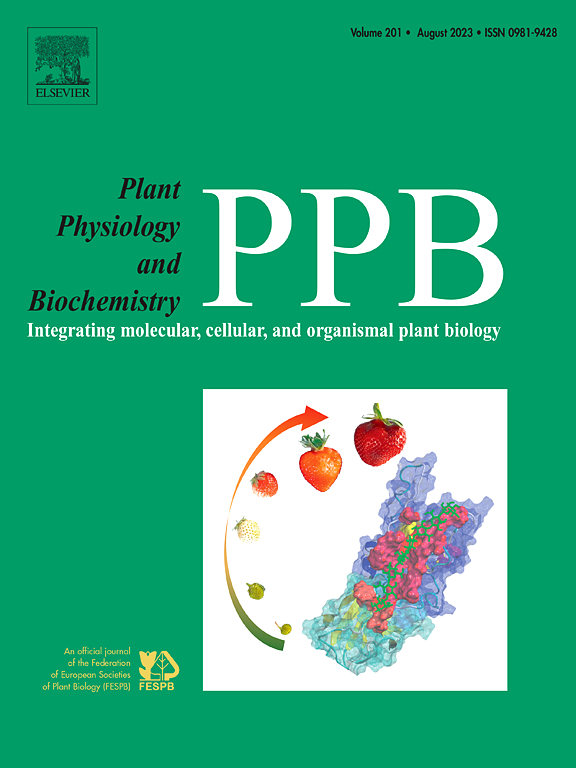Enhancing drought resilience in Brassica campestris: Antioxidant and physiological benefits of Ascophyllum nodosum extract and alginic acid
IF 5.7
2区 生物学
Q1 PLANT SCIENCES
引用次数: 0
Abstract
Global climate change is the reason behind extreme dry weather, which is the primary factor behind reduced crop growth and yield. To mitigate the detrimental effect of drought, biostimulants like Ascophyllum nodosum extract (ANE) and alginic acid (AA) are increasingly used, as they have demonstrated growth-promoting effects on plant. This study was designed to delve into the role of ANE and AA on drought affected rapeseed (Brassica campestris cv. BARI Sarisha-17). Moreover, the study gives a comparative illustration of ANE and one of its principal polysaccharide components AA and explores AA's ability to mimic or surpass the effects of the complete extract. Drought was applied from 15 days after sowing (DAS) by keeping soil moisture level at 25 % field capacity. The control plants were irrigated as per requirement with water. Foliar spraying of ANE (0.02 %) and AA (0.02 %) were initiated after plant establishment. Data on different morphophysiological and biochemical parameters were collected at 35 DAS. Water deficit condition reduced plant growth, biomass accumulation, water balance and chlorophyll pigments. It notably increased oxidative damage by increasing lipid peroxidation, hydrogen peroxide content, proline content, electrolyte leakage, and disrupting glyoxalase system which elevated reactive oxygen species in plants by suppressing antioxidants enzyme activities. Conversely, application of ANE and AA substantially alleviated the detrimental consequences of drought stress with AA being slightly more effective than ANE, by uplifting water balance and redox levels of ascorbate and glutathione. The activities of antioxidant defense and glyoxalase pathway enzymes were also enhanced by exogenous ANE and AA. Both ANE and AA enhanced drought tolerance but it was observed that foliar spraying of AA performed better by reducing oxidative damage and improving antioxidant enzyme activities over plants treated with ANE. These improvements play a crucial role in strengthening rapeseed's resistance to drought conditions.
增强油菜抗旱性:藤茎提取物和褐藻酸的抗氧化和生理效益
全球气候变化是造成极端干旱天气的原因,而极端干旱天气是导致作物生长和产量下降的主要因素。为了减轻干旱的不利影响,越来越多地使用诸如藤蔓提取物(ANE)和褐藻酸(AA)等生物刺激剂,因为它们对植物有促进生长的作用。本研究旨在探讨ANE和AA对干旱影响的油菜(Brassica campestris cv.)的作用。巴里Sarisha-17)。此外,该研究还对ANE及其主要多糖成分之一AA进行了比较说明,并探讨了AA模仿或超越全提取物效果的能力。从播种后15 d开始施用干旱,土壤水分水平保持在25%的田间容量。对照植株按需水量灌溉。在植株建立后开始叶面喷施0.02%的ANE和0.02%的AA。在35 DAS采集不同形态生理生化参数的数据。水分亏缺条件降低了植物的生长、生物量积累、水分平衡和叶绿素色素。它通过增加脂质过氧化、过氧化氢含量、脯氨酸含量、电解质泄漏和破坏乙二醛酶系统来增加植物的活性氧,从而抑制抗氧化酶的活性,从而显著增加氧化损伤。相反,施用ANE和AA通过提高水分平衡和谷胱甘肽和抗坏血酸的氧化还原水平,显著减轻了干旱胁迫的不利后果,AA的效果略优于ANE。外源ANE和AA也增强了抗氧化防御和乙二醛酶途径酶的活性。叶面喷施AA和ANE均能提高植株的抗旱性,但叶面喷施AA能更好地降低植株的氧化损伤,提高抗氧化酶活性。这些改良对增强油菜籽的抗旱性起着至关重要的作用。
本文章由计算机程序翻译,如有差异,请以英文原文为准。
求助全文
约1分钟内获得全文
求助全文
来源期刊
CiteScore
11.10
自引率
3.10%
发文量
410
审稿时长
33 days
期刊介绍:
Plant Physiology and Biochemistry publishes original theoretical, experimental and technical contributions in the various fields of plant physiology (biochemistry, physiology, structure, genetics, plant-microbe interactions, etc.) at diverse levels of integration (molecular, subcellular, cellular, organ, whole plant, environmental). Opinions expressed in the journal are the sole responsibility of the authors and publication does not imply the editors'' agreement.
Manuscripts describing molecular-genetic and/or gene expression data that are not integrated with biochemical analysis and/or actual measurements of plant physiological processes are not suitable for PPB. Also "Omics" studies (transcriptomics, proteomics, metabolomics, etc.) reporting descriptive analysis without an element of functional validation assays, will not be considered. Similarly, applied agronomic or phytochemical studies that generate no new, fundamental insights in plant physiological and/or biochemical processes are not suitable for publication in PPB.
Plant Physiology and Biochemistry publishes several types of articles: Reviews, Papers and Short Papers. Articles for Reviews are either invited by the editor or proposed by the authors for the editor''s prior agreement. Reviews should not exceed 40 typewritten pages and Short Papers no more than approximately 8 typewritten pages. The fundamental character of Plant Physiology and Biochemistry remains that of a journal for original results.

 求助内容:
求助内容: 应助结果提醒方式:
应助结果提醒方式:


